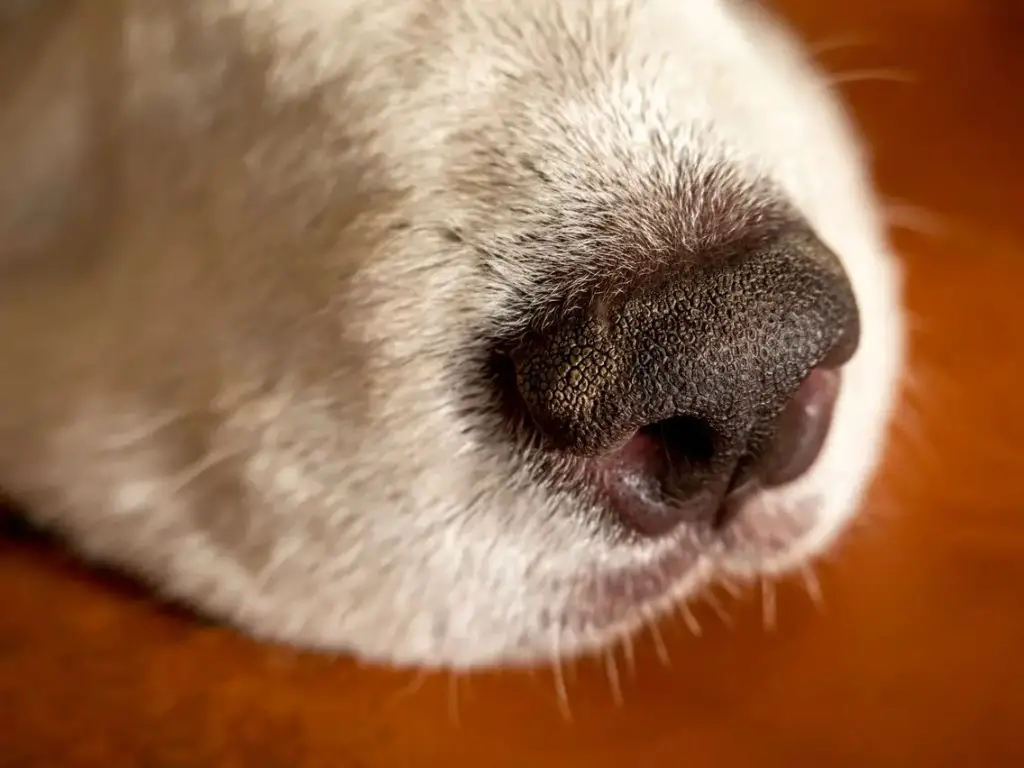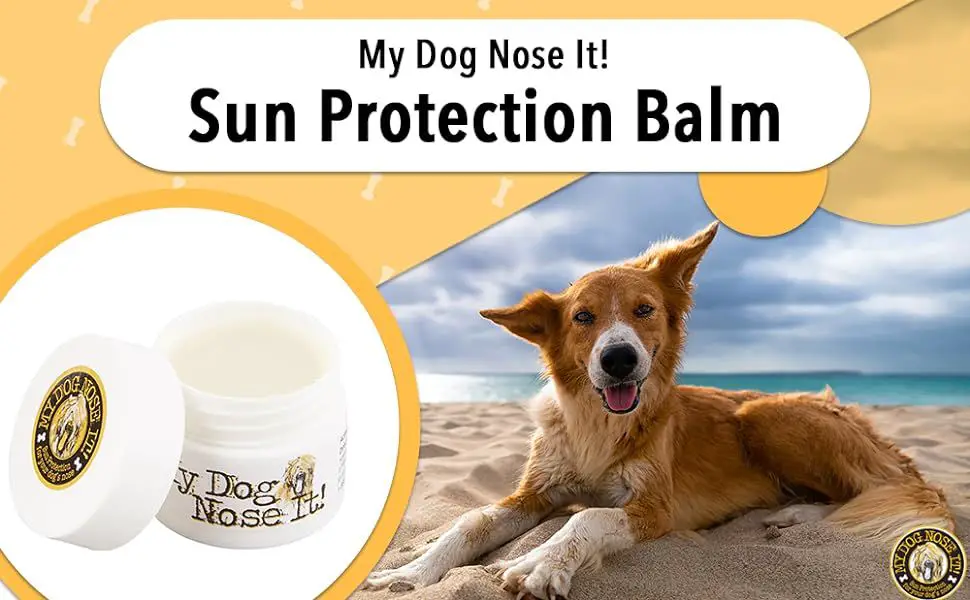Why Dogs’ Noses Need Moisturizing
Dog noses are exposed and prone to drying out and cracking. The nose’s thin outer layer of skin combined with constant contact with the ground, outdoor elements, and abrasive surfaces puts it at risk. Cracks in a dog’s nose can be very painful and lead to infections if bacteria invades through the broken skin. Appropriate moisturizing creates a protective layer that shields the sensitive nasal planum and helps prevent cracking and discomfort.

Dangers of Human Moisturizers
Human moisturizers often contain toxic ingredients that can be very hazardous to a dog’s health. Common toxic ingredients found in many human moisturizing products include zinc oxide, parabens, and phenoxyethanol.
These chemicals, while safe for human skin, can be absorbed into a dog’s bloodstream either orally or transdermally. Once in the bloodstream, the toxins can accumulate in the dog’s organs such as the liver and kidneys and cause damage over time.
Signs of toxicity include lethargy, loss of appetite, vomiting, and diarrhea. In severe cases, organ failure can occur. It’s important not to use any human moisturizing products on a dog’s sensitive nose.
Vet-Recommended Ingredients

There are several natural moisturizing ingredients that veterinarians recommend for caring for a dog’s sensitive nose. All-natural, organic oils like coconut, olive, and hempseed oil can help hydrate and nourish dry canine noses. The soothing properties of shea and cocoa butters also make them ideal for moisturizing dogs’ snouts. Beeswax is another ingredient vets suggest, as it provides a protective barrier without clogging pores. Vitamin E oils contain antioxidants that can help repair and restore damaged skin on a dog’s nose. By choosing vet-recommended ingredients like these, you can keep your dog’s nose supple and healthy.
Homemade Moisturizers
One of the best ways to moisturize your dog’s nose is to make your own homemade moisturizer. Homemade moisturizers allow you full control over the ingredients, so you can avoid any harsh chemicals. They also tend to be less expensive than commercial dog nose balms.
Some of the best ingredients for homemade dog nose moisturizers include:
- Coconut oil – Has naturally moisturizing properties.
- Beeswax – Creates a protective barrier.
- Shea butter – Deeply hydrating and soothing.
A simple recipe is to combine 1/2 cup coconut oil, 1/4 cup beeswax, and 1/4 cup shea butter in a double boiler. Once melted and combined, pour into a jar or tin and allow to cool completely before use. Apply a small amount to your dog’s nose 2-3 times per day.

You can also add a few drops of vitamin E oil for extra nourishment. Some other recipe variations include aloe vera gel for healing cracked noses or calendula for its anti-inflammatory properties.
The main benefits of homemade moisturizers are that you know exactly what’s in them, they’re affordable, and it’s easy to customize the recipe for your dog’s needs.
OTC Moisturizers
There are many high quality pre-made moisturizers for dogs’ noses available over-the-counter in pet stores and online. When shopping for a commercial moisturizer, look for products that contain all natural, non-toxic ingredients that are safe if licked off. Many quality brands use soothing, nourishing ingredients like olive oil, shea butter, vitamin E, and beeswax.
Some over-the-counter moisturizers also contain SPF to provide sun protection for dogs’ sensitive noses. Popular options include Warren London’s Pawdicure Nose Butter, Natural Dog Company’s Snout Soother, and Natural Dog’s Nose Butter. Always follow label directions and monitor your dog’s skin when first using a new product.
Application Tips
When applying a moisturizer to your dog’s nose, follow these tips to ensure safe and effective use:
Only apply to a clean, dry nose. Gently wash your dog’s nose with a pet-safe cleanser and pat dry before applying the moisturizer. Applying moisturizer to a wet or dirty nose won’t allow it to absorb properly.
Use sparingly and don’t over-moisturize. Just a small amount of moisturizer is needed to provide relief. Using too much can lead to irritation or clogged pores.
Reapply daily or as needed. Most moisturizers will need to be reapplied every day, especially in dry climates. If your dog’s nose feels dry later in the day, you can apply a little more.
Gently massage in. Rub the moisturizer into your dog’s nose in small, gentle circles. This helps it absorb into the skin for maximum moisturizing benefits.
With the proper application approach, you can keep your dog’s nose comfortably moisturized without any risk of overdoing it.
Signs of Improvement
When you start regularly moisturizing your dog’s nose, you should begin to see signs that their snout is healing and becoming more comfortable. Here are some improvements you can watch for:
Cracking and flaking will reduce. If your dog’s nose was dry and flaky, those crusty patches should start disappearing as the moisturizer hydrates their skin. Their nose will look and feel smoother.
Nose will appear smooth and hydrated. In addition to less cracking and flaking, the overall texture and appearance of your dog’s nose will improve. It will start looking glossy and moisturized instead of dull and dry.
Dog will seem more comfortable. If your dog was constantly licking or rubbing their snout, they should do this less often as the moisturizer soothes irritation. Your dog will act less bothered by their nose when you pet it or they touch it on surfaces.
When to See a Vet
While most cases of dry dog nose can be treated at home, it’s important to contact your veterinarian if your dog’s nose becomes very red, swollen, oozing, or irritated. These symptoms may indicate a more serious medical condition such as an infection or allergy that requires veterinary attention and treatment.
In particular, look out for symptoms like pustules, scabs, or discharge, which are indicative of an infection or inflammatory condition. Bacterial or fungal infections need to be diagnosed and treated with prescription medications to prevent worsening.
You should also consult your vet if your dog’s nose remains chronically dry and cracked despite home moisturizing efforts. Your vet can rule out underlying diseases and determine if medicated ointments are needed for stubborn dry nose.
Veterinary exam and testing may identify underlying problems like hormonal disorders, autoimmune disease, cancer, or other systemic conditions leading to nose irritation. Addressing the root cause is key to restoring comfort and preventing progression.
While moisturizing provides palliative care, only a vet can properly diagnose and treat complicating health factors. Schedule an appointment if basic home remedies don’t bring relief within a week or if any abnormal discharge or swelling develops.
Caring for Dog’s Entire Snout
While the nose tends to be the area most prone to dryness on a dog’s face, caring for their entire snout is important for their health and comfort. Here are some tips for keeping your dog’s whole snout in good condition:
Apply a dog-safe balm or moisturizer to your dog’s lips if they appear chapped or irritated. Their lips can dry out just like their nose. Gently rub a small amount of moisturizer onto their lips 1-2 times per day.
Gently wipe inside skin folds around your dog’s face daily. Areas like the folds around their mouth or eyes can collect dirt, moisture and debris and need regular cleaning. Use a warm, damp cloth to gently wipe away any buildup.
Keep your dog’s whiskers trimmed if needed. While whiskers serve an important sensory purpose for dogs, overly long whiskers can collect dirt and bacteria. Use blunt scissors to trim their whiskers if they become extremely long or unsightly.
Check their entire muzzle each day for any new bumps, lesions or unusual odors which could indicate an infection or condition needing veterinary attention. Catching problems early maximizes the chances of effective treatment.
Ensuring Ongoing Health
A healthy dog nose requires more than just a good moisturizer. Here are some tips for protecting your dog’s snout and ensuring ongoing nasal health:

Protect from sun and wind. Use a canine snood or sunscreen when your dog will be out in intense sun or cold wind for long periods. The elements can dry out and damage their tender noses over time.
Provide a wholesome diet. Make sure your dog’s food contains oils that nourish skin and coat from the inside out. Fish oils, olive oil, flaxseed oil, etc. will support their body’s natural moisture production.
Monitor for issues. Check your dog’s nose routinely for any unusual dryness, cracking, discharge or odor which could indicate more serious health issues. Look out for signs of tumors, parasites, or other abnormalities needing a vet’s attention.
Keeping your dog’s entire nasal area healthy will reduce the need for extra moisturizing and medications over the long run.